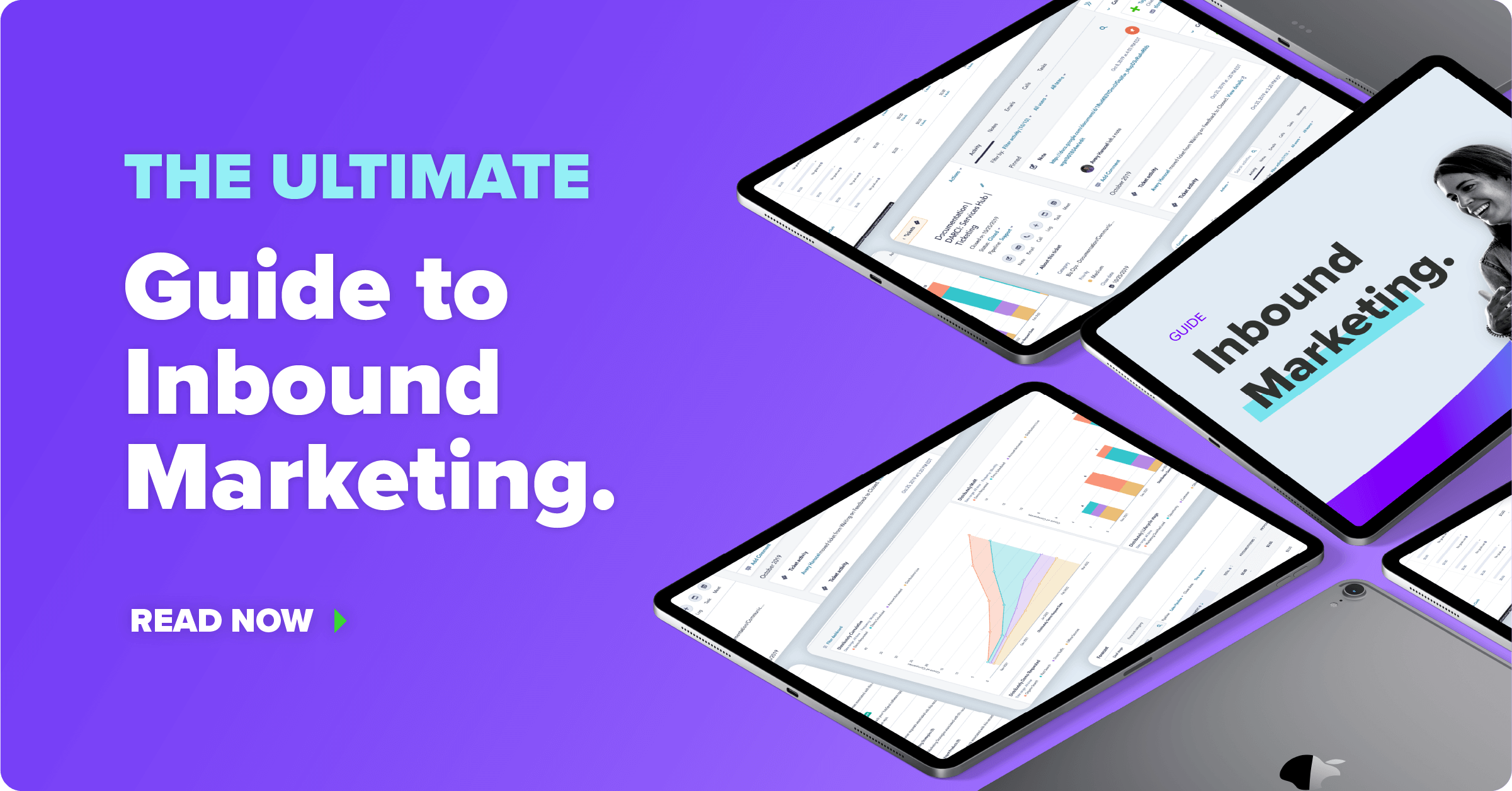8 Steps to Transitioning Your Company to Inbound Marketing
Buyers have more power over the marketing and sales process than ever before. Cold calling and targeting them with generic ads is no longer enough to fuel long term success for your company. Instead, you need to draw prospects to your company with valuable, helpful content and nurture them into becoming customers.
Inbound marketing puts customers in the center of your company’s efforts and sets your business up for long-term success. It won’t have the same immediate impact as outbound methods, but inbound will continue to pay off well after your initial investment. Plus, the leads you bring in through inbound methods typically are a better fit and have a higher lifetime value.
“The stuff that you’re doing today in inbound isn’t necessarily going to benefit you for weeks or months down the line — but it’s going to continue to benefit you beyond that as well,” New Breed’s Head of Demand Generation Guido Bartolacci says. “Whereas outbound is kind of the opposite. It’s going to benefit you immediately, and you’re going to be able to see and understand why what we did worked and what it did for us, but it’s not going to last for you beyond that.”
If you’re looking to change from a short-term oriented marketing strategy to something that will position your company for long-term success, here’s how to implement an inbound approach in eight steps.
1. Set Expectations for the Transition Within Your Company
Outbound and inbound drive results differently, and you’ll need to prepare the rest of your company for that. Digital outbound methods produce short-term, direct results. Inbound takes longer to have an impact and can be harder to measure — even though its impact is greater than outbound’s in the long-term.
When you start to transition to inbound, you probably won’t want to drop your outbound tactics cold turkey. If you stop outbound at the same time that you start inbound, you’ll have no marketing gaining traction for a couple of weeks or even months, because it’ll take time for your inbound to take off.
“You’ll need to have something going to maintain your current pace as you start to transition to or layer in inbound,” Guido says. “You won’t be able to turn outbound off and turn inbound on and make a clean switch like that.”
After your inbound efforts start to produce results, then you can peel away the outbound and start to rely more on inbound until it becomes your primary source of marketing leads.
For the smoothest transition, you should plan and define how inbound will work for your company in advance: what tactics will you start out with? How will you balance inbound and outbound efforts? Then you need to set those expectations throughout the company so everyone is on the same page.
2. Understand Your Funnel and Lifecycle Stages
-1.png)
The marketing and sales funnel is a way of visualizing how inbound leads are attracted to your company and nurtured toward becoming customers. At the top of the funnel, you have anonymous visitors. As a prospect progresses through the funnel, they learn more about the value your company provides, and you learn more about their needs.
When prospects transition from MQL to SQL, they enter the sales pipeline, and once they close as customers, they become the center of your inbound flywheel.
Within the funnel, there are six lifecycle stages:
- Visitor: Anonymous people who have shown interest in your content
- Lead: Contacts who have provided your company with information about themselves
- MQL: Leads that marketing thinks are a good fit for your product or service
- SQL: Leads that sales thinks are good fits and worth pursuing
- Opportunity: Prospects who are considering your solution and in talks with sales
- Customer: People who’ve committed to a business engagement with your company
The specific details of what each stage means will vary from company to company, so it’s essential to determine what actions trigger each lifecycle stage for your prospects. Those triggers could be based on a prospect’s fit, their interests and behaviors or some combination of those factors.
3. Define Your Buyer Personas
Buyer Personas are semi-fictional representations of your ideal customer. They help you visualize the audience to which you’re targeting your marketing efforts.
“You need to understand who you’re selling to, what they care about, where they live online and how you can help them — at the very least,” Guido says.
Buyer personas contain a combination of demographic and firmographic information along with information on what motivations and challenges they have in their day-to-day life.
“The better you know your prospect, the more likely it is that you’ll be able to create content that resonates with them that will attract, engage and delight them,” Guido says.
By understanding who your personas are and what they care about, you’ll be able to develop content that will attract them to your website and nurture them through the lifecycle stages. The sequences of content that guide your personas down the funnel are called conversion paths.
4. Develop Inbound Content,
Once you know who you’re targeting with your inbound marketing efforts, you need to develop and implement a content strategy that gets your prospects from where they currently are to where you want them.
You may have some existing content already, but in order to effectively launch an inbound strategy, you need to have enough content to fill out a conversion path for each buyer persona.
Conversion paths contain three types of content:
- Top-of-the-funnel (ToFu) content focuses on educating prospects about their challenges and is typically in the form of blog posts, social media content or short videos
- Middle-of-the-funnel (MoFu) content goes a little more in-depth on your personas’ pain points and starts to present potential solutions. This is typically in the form of guides,ebooks, checklists, templates and webinars
- Bottom-of-the-funnel (BoFu) content works to convince prospects that your company and your solution is the best choice for them. BoFu content includes product walkthroughs, case studies and personalized assessments
Creating that content requires a variety of skill sets, so you may need to hire new team members or outsource content creation.
5. Launch a Sales-Ready Website
“Remember the 4 P's — product, price, place, promotion? You can think of your website as your place,” Guido says. “It's your online storefront where all of your prospects are going to learn about who you are and what you do. Without a solid website, all of that work you've done creating content for your personas will go to waste.”
At New Breed, we like to think of websites as your #1 salesperson. Your website should simultaneously help visitors find the information they need while collecting data that can help your marketing and sales team qualify and nurture them.
Your website needs strong messaging that resonates with your audience and clear conversion points where visitors can fill out a form to exchange information for a content offer.
If your site doesn’t contain those things, you should consider a website redesign.
6. Invest in Marketing Automation
“If you’re a business that’s trying to adopt inbound marketing, you’re going to need to collect people’s information one way or another,” Guido says. “That could be through forms. That could be through conversational marketing. But either way, marketing automation will provide you with a tool through which you can collect people’s information so you can stay up to date with them and continue to email them and enroll them in ongoing lead nurtures and workflows to try and generate more interest and add more value."
Marketing automation platforms are essential to streamlining your inbound marketing efforts. From sending emails to posting on social to establishing nurture workflows to managing forms, marketing automation tools allow your team to do a lot more work with less time and people.
“A marketing automation tool can help you do a lot with a small team because the opposite of using a marketing automation tool is having someone manually send out every single email and post natively every social post that you write,” Guido says.
Additionally, marketing automation platforms help you track the actions your leads are taking on your website. Most marketing automation tools can track how prospects interact with your content and push that information into your CRM so you can understand where people are converting and what’s the most effective way to nurture a prospect from lead to customer.
7. Do Sales Enablement
Because your inbound marketing attracts and nurtures leads instead of pushing content at them intrusively, those leads will be accustomed to a more contextual and less pushy style of communication. That changes how your sales team will need to follow up with inbound leads in order to close them effectively.
“You’re going to give your sales team a lot more information about who [your leads] are and how they’ve interacted with your business up to this point, so ideally you’re empowering your sales rep or enabling your sales rep with a lot more information than they would typically have about the person they’re about to reach out to,” Guido says. “But when you do reach out, you need to keep that in mind because if you treat them like someone who’s never heard of you before, they’re gonna think you’re crazy.”
Inbound marketing will need to be followed up with inbound sales, so in order to transition your marketing style, you’ll need to train your sales team on how to effectively handle the new style of leads that you’re generating.
Instead of trying to gain interest from high-fit prospects, your sales reps will need to determine the level of fit of your already-interested inbound leads and then nurture them using the content they’ve already been interacting with.
Since this is stylistically different from how outbound sales operates, it might be worth bringing in new reps who won’t have to break long-standing habits since not every sales rep can easily transition from traditional sales methods to the inbound approach.
8. Track and Report on Your Efforts
Once you start implementing inbound, give it time to take off and then start analyzing what tactics are working best for your company. To optimize your marketing strategy over time, you need to be able to tie results to the marketing tactic that brought them about.
“More often than not, that’s going to involve some sort of tool. Google Analytics is a good starting point to be able to measure how well your website is doing, but eventually, you’re going to want to track all the leads you are creating from the forms you are using the marketing automation tool that you have and how those leads are progressing through your funnel,” Guido says.
Looking at the performance of your various content and how leads are moving through the lifecycle stages can help you identify what’s working well for you and what can be better.
Quinn Kanner
Quinn is a writer and copyeditor whose work ranges from journalism to travel writing to inbound marketing content.





